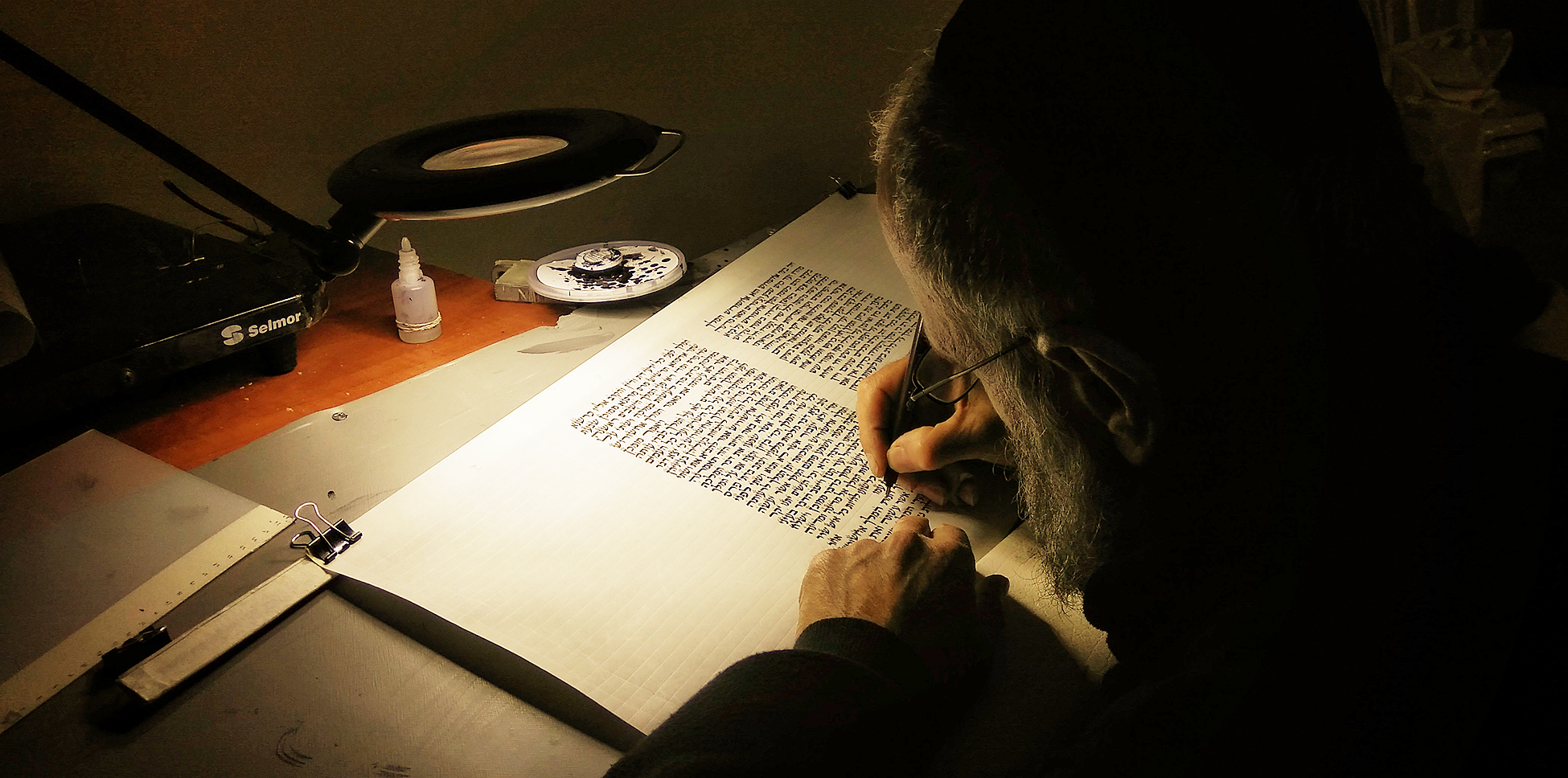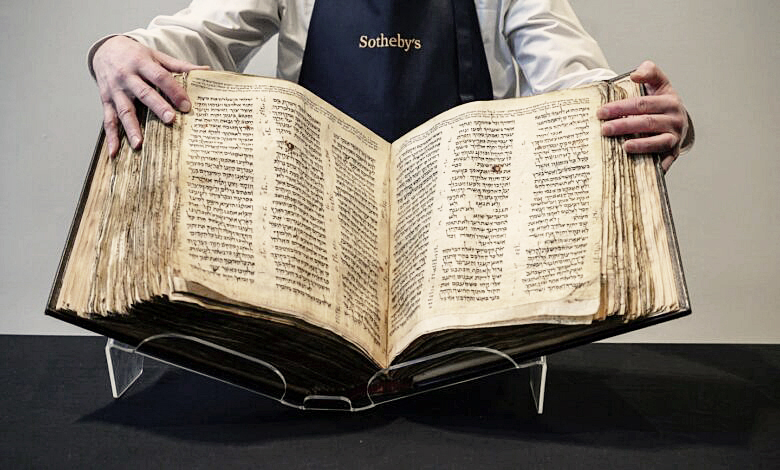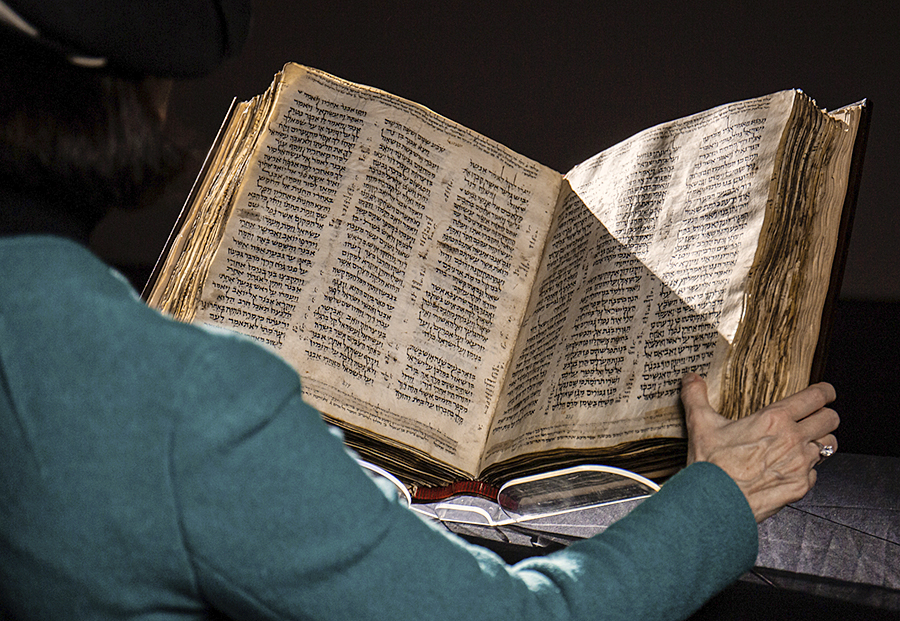
Bible, History, Archaeology
Bible,
History,
Archaeology
The Sassoon codex,
the oldest Hebrew Bible?
The oldest and most complete Hebrew Bible (Tanakh), nearly eleven hundred years old, will be sold at auction on May 17, 2023 for an estimated price of between $30 and $50 million (between 28 and 46 million euros), Richard Austin, head of antiquarian books and manuscripts at Sotheby's, told AFP.

A detail from the Sassoon codex, probably the oldest complete Hebrew Bible to date. © Ed Jones/AFP.
 Image opposite: the Sassoon codex: the oldest complete Hebrew Bible, exhibited at Sotheby's, New York, February 15, 2023. Ed Jones/AFP.
Image opposite: the Sassoon codex: the oldest complete Hebrew Bible, exhibited at Sotheby's, New York, February 15, 2023. Ed Jones/AFP.
The codex measures 48 cm by 36 cm and contains 274 leaves. It is written on parchment, with three columns per page, and a total of 20 lines per column. The manuscript is written in square Hebrew script. It is of high quality, and the handwriting is clear and legible, with very few errors or corrections. The manuscript is illuminated with decorative motifs in red and blue ink, which are used to mark the beginning of new sections and books.
Its layout is reminiscent of the Torah scrolls read in synagogue.
In 1891, the manuscript was acquired in the 1900s by British collector David Solomon Sassoon (1880-1942), a prominent member of the Jewish community in Bombay, India, who had assembled the world's largest and most important private collection of Hebrew manuscripts. He held a collection of 412 manuscripts and had a particular affinity for Bibles. He added the codex to his collection and named it codex Sassoon. The latter dates back to around 900 AD. This date remains approximate, however, as no in-depth study or scientific publication has yet been made.
 A page from the codex
A page from the codex
The sale is scheduled to take place in May, during the classic spring auction season for contemporary, modern and impressionist art, organized by the New York behemoths of the sector: Sotheby's, owned by French-Israeli tycoon Patrick Drahi, and its rival Christie's, controlled by French billionaire François Pinault's holding company Artémis.
Image opposite: a page from the Sassoon codex containing a passage from Exodus 25:23-35. Ed Jones/AFP.
This Bible in Hebrew - the original language of the Old Testament, which also contains a few passages in Greek and Aramaic - belonged to major collectors in the 20th century; it may well go to an institution for further study, including abroad.
The Sasson codex is in an exceptional state of preservation, with only eight leaves missing. It links the 24 books of the Hebrew Bible with their punctuation, vowels and accents, as shown in the image opposite.
The Hebrew Bible is divided into three parts: the Pentateuch (Torah), the Prophets (Nevi'im) and the Writings (Ketuvim).
The text of the manuscript is the Masoretic text, which is the traditional Hebrew text of the Hebrew Bible. This text is considered the most authoritative and accurate version of the Hebrew Bible. The manuscript also contains some targumim, which are Aramaic commentaries on the Hebrew text. These Targumim are written by a different hand, and are thought to have been added to the manuscript at a later date.
This version of the Bible, more complete than the Aleppo codex - probably written between 910 and 930 A.D., but about a third of its pages are missing., The manuscript was first authenticated by carbon 14 and confirmed by rapid paleographic and codicological research. It has survived more than a millennium in the hands of several public and private collectors, many of whose names are mentioned in the manuscript.
 Official information from Sotheby's.
Official information from Sotheby's.
On May 17, 2023, the thousand-year-old Hebrew Bible, the oldest known near-complete Bible, was purchased at auction in New York for $38.1 million (actually 33.5 million, but with fees and bonuses, the final price reached $38.1 million) by the former United States in Romania and philanthropist Alfred Moses and his family, who donated it to the Jewish People's Museum (ANU) in Tel Aviv, Israel.
Image opposite: the Sassoon codex, the oldest Hebrew Bible, dating from the late 9th or early 10th century. It was created in the early Middle Ages by scholars known as the Massorets. The cover of the manuscript is made of dark brown leather, with metal parts and clasps. Ed Jones/AFP.

Images from left to right:
- The Sasson codex was exhibited for a few days in March at the ANU's Museum of the Jewish People in Tel Aviv, before being returned for sale at Sotheby's in New York. «This is one of the rarest, most unique and unifying documents that has ever existed,» Irina Nevzlin, President of the ANU Board of Directors, told JTA. «For us, having it in a museum where it will be accessible to all those millions of people is something that can strengthen our roots and identity, because it's something eternal.» © Jessica Steinberg/Times of Israel.
– Benjamin Doller, auctioneer at Sotheby's bidding on the Sassoon codex, New York, May 17, 2023. Angela Weiss/AFP.
 His reappearance
His reappearance
Image opposite: David Solomon Sassoon, at his desk, in front of his typewriter in 1930. Public domain.
The codex was considered lost for almost 600 years after the destruction of the northeastern Syrian synagogue in which it was housed, and reappeared in 1929. It has since been privately owned and is currently the property of Swiss financier and collector Jacqui Safra, who acquired it in 1989 from the British Rail Pension Fund for approximately $320,000, or $1.4 million today.
«This is the first time this text has appeared in a form that is truly readable and understandable.», explained Sharon Liberman Mintz, a specialist in Jewish texts at Sotheby's. Regarding its high price, she added that the codex was already expensive at the time, and that it took over a hundred animal skins to make it. She noted that this Bible was written by a single scribe (in its Hebrew part) and that it mentions landmarks enabling us to follow, over the years, its various owners, revealing the name of the last one before its disappearance, when the synagogue where it had been displayed, for a time, had been destroyed in the Syrian town of Makisin (now Markada).
Conclusion
Image opposite: A specialist studies the Sassoon codex. © Sotheby's.
In conclusion, the Sassoon codex is a precious and significant manuscript of the Hebrew Bible. Its rarity, unique features and historical significance make it an important resource for scholars and historians of Jewish and biblical studies. The manuscript provides an insight into the development of the Hebrew Bible, and is an important example of the Masoretic text, which is the traditional text of the Hebrew Bible. The codex has also become a popular cultural icon, representing the fascination and appeal of ancient manuscripts and texts.



 A page from the codex
A page from the codex
 His reappearance
His reappearance